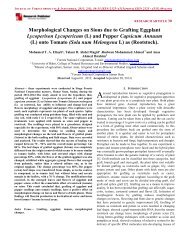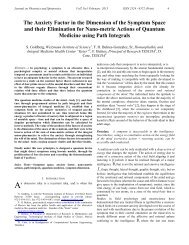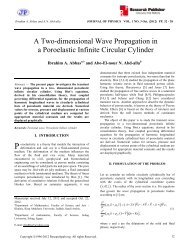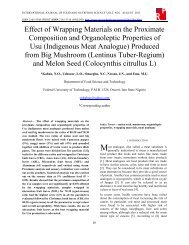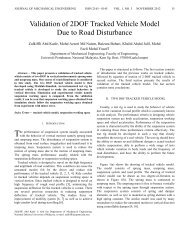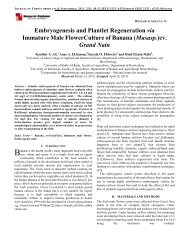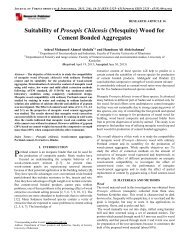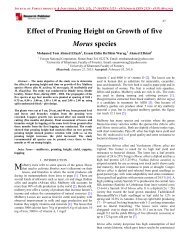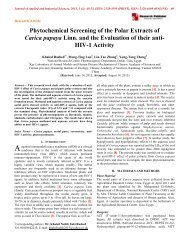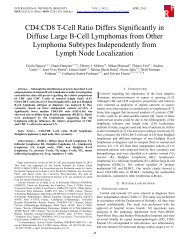Estrogen Impact on Autoimmunity Onset and Progression: the ...
Estrogen Impact on Autoimmunity Onset and Progression: the ...
Estrogen Impact on Autoimmunity Onset and Progression: the ...
- No tags were found...
You also want an ePaper? Increase the reach of your titles
YUMPU automatically turns print PDFs into web optimized ePapers that Google loves.
INTERNATIONAL TRENDS IN IMMUNITY VOL.1 NO.2 APRIL 2013ISSN 2326-3121 (Print) ISSN 2326-313X (Online) http://www.researchpub.org/journal/iti/iti.htmlc<strong>on</strong>tribute to <strong>the</strong> gender bias in SLE modulatingselected miRNA expressi<strong>on</strong> [50]. miR-146a, whichis a negative regulator of <strong>the</strong> IFN-α pathway, <strong>and</strong>miR125a, which negatively regulates <strong>the</strong>inflammatory chemokine RANTES, wereprofoundly decreased in PBMC from patients withSLE as compared to healthy d<strong>on</strong>ors [51, 52].C<strong>on</strong>versely, miR21 <strong>and</strong> miR148a, which c<strong>on</strong>tributeto DNA hypomethylati<strong>on</strong> in lupus CD4+ T cells [53],were found up-regulated [54]. Notably, Dai et al. [55]observed that miR148a was up-regulated whereasmiR146a <strong>and</strong> miR125a were down-regulated by E2,at least in splenocytes from estrogen-treated mice.Toge<strong>the</strong>r, <strong>the</strong> aforementi<strong>on</strong>ed studies show thatmiR-146a, miR-125a, <strong>and</strong> miR-148A aredysregulated in SLE c<strong>on</strong>tributing to diseasepathogenesis <strong>and</strong> estrogens regulate <strong>the</strong>se miRNAexpressi<strong>on</strong> [50].As stated above, ERα <strong>and</strong> ERβ are encoded by <strong>the</strong>ESR1 <strong>and</strong> ESR2 genes which are both polymorphic.rs2234693 <strong>and</strong> rs4986938 are two single nucleotidepolymorphisms (SNPs) whose C <strong>and</strong> A variantsincrease transcripti<strong>on</strong> of ESR1 <strong>and</strong> ESR2,respectively. Although no associati<strong>on</strong>s betweenrs2234693 genotype <strong>and</strong> SLE were found, thispolymorphism has been suggested to influence <strong>the</strong>risk for particular forms of disease [56-58]. Notably,two studies performed in Asian [57] <strong>and</strong> Caucasian[58] populati<strong>on</strong>s reported that <strong>the</strong> T allele ofrs2234693 (ESR1) was associated with early <strong>on</strong>set ofSLE. C<strong>on</strong>versely, in ano<strong>the</strong>r study, Kisiel et al. [59]reported <strong>the</strong> associati<strong>on</strong> of <strong>the</strong> allele C of rs2234693(ESR1) with juvenile SLE, <strong>and</strong> <strong>the</strong>y also found anassociati<strong>on</strong> of allele A of rs4986938 (ESR2) withadult SLE. In c<strong>on</strong>trast, two genome-wide associati<strong>on</strong>studies in SLE were published but nei<strong>the</strong>r reportedassociati<strong>on</strong> with <strong>the</strong> ESR1 or ESR2 variants [60, 61].In summary, genetic variati<strong>on</strong> in estrogen-relatedpathways might be important for SLE development,but this field needs fur<strong>the</strong>r investigati<strong>on</strong>s taking intoaccount clinical characteristics of patients.Studies of mice models revealed that lupus alsopredominates in females. Moreover, ovariectomizedfemale (NZBxNZW)F1 mice live l<strong>on</strong>ger <strong>and</strong>castrated males develop an accelerated autoimmunedisease [62]. The role of ERα in lupus-like diseasehas been suggested by different studies. A study in(NZBxNZW)F1 mice that utilized ERα-selective <strong>and</strong>ERβ-selective ag<strong>on</strong>ists indicated that <strong>the</strong> ERα27activati<strong>on</strong> plays an immunostimulatory role inmurine lupus, whereas <strong>the</strong> ERβ activati<strong>on</strong> has mildimmunosuppressive effects [63]. The key role ofERα, but not ERβ, in <strong>the</strong> pathogenesis of lupus wasfur<strong>the</strong>r c<strong>on</strong>firmed in experiments with ERα −/−NZM2410 <strong>and</strong> ERα −/− MRL/lpr lupus pr<strong>on</strong>e mice.ERα-deficient mice manifested significantly lesspathologic renal disease <strong>and</strong> proteinuria <strong>and</strong> hadsignificantly prol<strong>on</strong>ged survival compared towild-type mice [64]. Since anti-dsDNA antibodylevels <strong>and</strong> number <strong>and</strong> percentage of B/T cells werenot significantly impacted by ERα genotype, <strong>the</strong>authors hypo<strong>the</strong>sized that <strong>the</strong> primary benefit of ERαdeficiency in lupus nephritis was via modulati<strong>on</strong> of<strong>the</strong> innate immune resp<strong>on</strong>se. In a subsequent study,<strong>the</strong>y found that ERαKO-derived cells have asignificantly reduced inflammatory resp<strong>on</strong>se afterstimulati<strong>on</strong> with TLR ag<strong>on</strong>ists [65]. In fact, in <strong>the</strong>absence of ERα, <strong>the</strong> inflammatory resp<strong>on</strong>se to TLR9stimulati<strong>on</strong> was significantly blunted. Additi<strong>on</strong>ally,ERα was required for TLR-induced stimulati<strong>on</strong> ofIL-23R expressi<strong>on</strong>, which may have paracrine <strong>and</strong>autocrine effects <strong>on</strong> T cells <strong>and</strong> dendritic cellsinvolved in <strong>the</strong> IL-23/IL-17 inflammatory pathway[65] . In c<strong>on</strong>trast, ERβ deficiency had no effect <strong>on</strong>lupus activity [64]. Overall, <strong>the</strong>se data implicate <strong>the</strong>role of estrogen <strong>and</strong> ERα in <strong>the</strong> progressi<strong>on</strong> oflupus-like disease.V. ESTROGEN RECEPTOR MODULATORSA. Envir<strong>on</strong>mental estrogensIn additi<strong>on</strong> to <strong>the</strong> endogenous estrogens, <strong>the</strong> immunesystem can be targeted by natural (phytoestrogens<strong>and</strong> mycoestrogens) or syn<strong>the</strong>tic (xenoestrogens)compounds with estrogenic activity, i.e., <strong>the</strong>estrogenic endocrine disruptors (EEDs) [66, 67].Xenoestrogens are widely found in plastics (e.g.,bisphenol-A, BPA), detergents <strong>and</strong> surfactants (e.g.,octylphenol, n<strong>on</strong>ylphenol), pesticides (e.g.,methoxychlor, chlordec<strong>on</strong>e, <strong>and</strong>o,p’-dichlorodiphenyltrichloroethane, DDT), <strong>and</strong>industrial chemicals (e.g.,2,3,7,8-tetrachlorodibenzo-p-dioxin, TCDD). Thethree major classes of phytoestrogens are isoflav<strong>on</strong>es,coumestans, <strong>and</strong> lignans. Genistein <strong>and</strong> daidzein are<strong>the</strong> major bioactive isoflav<strong>on</strong>es, principally availablein soybean <strong>and</strong> soy products. It is worthy to underline



